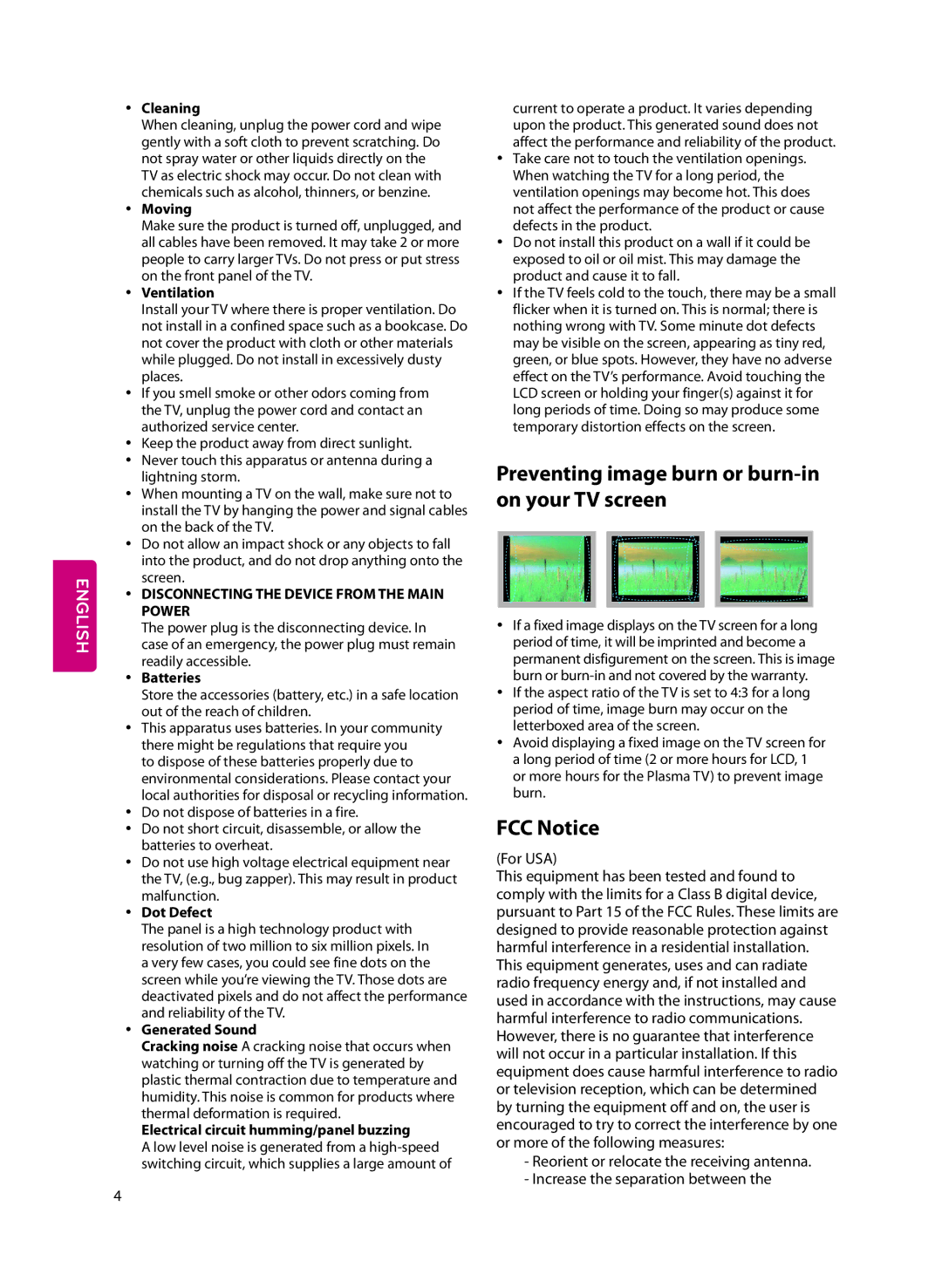
ENGLISH
yy Cleaning
When cleaning, unplug the power cord and wipe gently with a soft cloth to prevent scratching. Do not spray water or other liquids directly on the TV as electric shock may occur. Do not clean with chemicals such as alcohol, thinners, or benzine.
yy Moving
Make sure the product is turned off, unplugged, and all cables have been removed. It may take 2 or more people to carry larger TVs. Do not press or put stress on the front panel of the TV.
yy Ventilation
Install your TV where there is proper ventilation. Do not install in a confined space such as a bookcase. Do not cover the product with cloth or other materials while plugged. Do not install in excessively dusty places.
yy If you smell smoke or other odors coming from the TV, unplug the power cord and contact an authorized service center.
yy Keep the product away from direct sunlight.
yy Never touch this apparatus or antenna during a lightning storm.
yy When mounting a TV on the wall, make sure not to install the TV by hanging the power and signal cables on the back of the TV.
yy Do not allow an impact shock or any objects to fall into the product, and do not drop anything onto the screen.
yy DISCONNECTING THE DEVICE FROM THE MAIN
POWER
The power plug is the disconnecting device. In case of an emergency, the power plug must remain readily accessible.
yy Batteries
Store the accessories (battery, etc.) in a safe location out of the reach of children.
yy This apparatus uses batteries. In your community there might be regulations that require you
to dispose of these batteries properly due to environmental considerations. Please contact your local authorities for disposal or recycling information.
yy Do not dispose of batteries in a fire.
yy Do not short circuit, disassemble, or allow the batteries to overheat.
yy Do not use high voltage electrical equipment near the TV, (e.g., bug zapper). This may result in product malfunction.
yy Dot Defect
The panel is a high technology product with resolution of two million to six million pixels. In a very few cases, you could see fine dots on the screen while you’re viewing the TV. Those dots are deactivated pixels and do not affect the performance and reliability of the TV.
yy Generated Sound
Cracking noise A cracking noise that occurs when watching or turning off the TV is generated by plastic thermal contraction due to temperature and humidity. This noise is common for products where thermal deformation is required.
Electrical circuit humming/panel buzzing
A low level noise is generated from a
current to operate a product. It varies depending upon the product. This generated sound does not affect the performance and reliability of the product.
yy Take care not to touch the ventilation openings. When watching the TV for a long period, the ventilation openings may become hot. This does not affect the performance of the product or cause defects in the product.
yy Do not install this product on a wall if it could be exposed to oil or oil mist. This may damage the product and cause it to fall.
yy If the TV feels cold to the touch, there may be a small flicker when it is turned on. This is normal; there is nothing wrong with TV. Some minute dot defects may be visible on the screen, appearing as tiny red, green, or blue spots. However, they have no adverse effect on the TV’s performance. Avoid touching the LCD screen or holding your finger(s) against it for long periods of time. Doing so may produce some temporary distortion effects on the screen.
Preventing image burn or burn-in on your TV screen
yy If a fixed image displays on the TV screen for a long period of time, it will be imprinted and become a permanent disfigurement on the screen. This is image burn or
yy If the aspect ratio of the TV is set to 4:3 for a long period of time, image burn may occur on the letterboxed area of the screen.
yy Avoid displaying a fixed image on the TV screen for
a long period of time (2 or more hours for LCD, 1 or more hours for the Plasma TV) to prevent image burn.
FCC Notice
(For USA)
This equipment has been tested and found to comply with the limits for a Class B digital device, pursuant to Part 15 of the FCC Rules. These limits are designed to provide reasonable protection against harmful interference in a residential installation. This equipment generates, uses and can radiate radio frequency energy and, if not installed and used in accordance with the instructions, may cause harmful interference to radio communications. However, there is no guarantee that interference will not occur in a particular installation. If this equipment does cause harmful interference to radio or television reception, which can be determined by turning the equipment off and on, the user is encouraged to try to correct the interference by one or more of the following measures:
-Reorient or relocate the receiving antenna.
-Increase the separation between the
4
